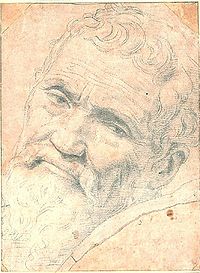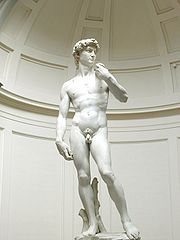Posts Tagged ‘renaissance’
Michelangelo: His Life and Times
Posted on: January 6, 2009
Michelangelo di Lodovico Buonarroti Simoni was born in Caprese in Tuscany, Italy in 1475.
He was a Renaissance painter, sculptor, architect, poet and engineer, and though he much preferred sculptures to paintings, two of his paintings – the scenes from Genesis on the ceiling of the Sistine Chapel and The Last Judgment – are considered to be some of the most influential fresco works in the history of western art.
Unlike many people who lived in the Middle Ages, Michelangelo lived to the ripe old age of 88, though during the most of those 88 years he was, to put it simply, pretty crabby. In his youth, he had gotten into a fight with another sculptor, and his nose got broken permanently.

Michelangelo never married in his lifetime.
Michelangelo’s career started when his father sent him to study grammar with Francesco da Urbino in Florence when he was still very young. However, he disliked studying, opting instead to copy paintings from churches and hang out with other painters.
When Michelangelo was 13, he apprenticed in painting with Domenico Ghirlandaio, who was a significant fresco painter, and then in sculpture with Bertoldo di Giovanni, who was the head teacher at a school founded by Lorenzo de Medici – who was at that time Florence’s ruler. Then, in 1489, Lorenzo de Medici, asked Ghirlandaio for two of his best students, and Ghirlandaio sent over Michelangelo and Francesco Granacci.
Michelangelo attended Lorenzo’s school from 1490 – 1492. It was here that he met many literary personalities and created Madonna on the Rocks (1490 – 1492) and Battle of the Centaurs (1491 – 1492), the latter of which was commissioned by Lorenzo de Medici.
When Lorenzo de Medici died in 1492, Michelangelo returned to his father’s house and there he carved a wooden crucifix for the Santa Maria del Santo Spirito church because they had ever so kindly given him some corpses from the churches’ hospital, thus allowing him to study the human anatomy.
That may sound gross to you and me, but in those times knowledge of the human anatomy was scarce, and both Michelangelo and his rival, Leonardo da Vinci, were very interested in human anatomy.

Leonardo da Vinci had many futuristic ideas when he was alive, such as working toilets.
Leonardo da Vinci and Michelangelo’s rivalry extended throughout both their careers. How did they become rivals? Well, though Leonardo da Vinci was nearly 25 years older than Michelangelo, they were both contenders for the title of “Renaissance Man”. They were both geniuses and extremely gifted in the art field. Oh yeah, and they both hated each other from the moment they met.
One of the reasons why that is (or the only reason, really) is that because of Leonardo’s age, he had already become old news when Michelangelo became the ‘it’ person. When Michelangelo rose to stardom, Leonardo was 51 and his hair and beard had turned white and he was pretty much old news. And so when Michelangelo started getting all the jobs that Leonardo wanted, Leonardo became exceedingly jealous.
One thing that’s similar about Michelangelo and Leonardo da Vinci is their sexuality. Both of them have had their sexuality questioned, analysed and studied. While both of them kept their private lives private, Michelangelo’s poems gave him away. For example, when Cecchino dei Bracci died just a year after they met in 1543, it inspired Michaelangelo to write 48 epigrams for his funeral.
However, Michelangelo’s greatest love was Tommaso dei Cavalieri, for whom he wrote almost 300 sonnets and madrigals. Cavalieri’s feelings for Michelangelo were mutual, as demonstrated in his written words: I swear to return your love. Never have I loved a man more than I love you, never have I wished for a friendship more than I wish for yours.
The true nature of their relationship is still under speculation today. And it got all the more complicated when Michelangelo’s nephew, Michelangelo the Younger, recognized the implications of the poems and changed the gender of the pronouns. But then, in 1893, when John Addington Symonds, the early British homosexual activist, translated the original poems into English, he undid the gender change and made things clearer.

The Statue of David - Michelangelo had a great love for the male beauty.
Michelangelo’s life was certainly an interesting one. The sheer volume of his letters and various sketches prove that he is the best documented artist of the 16th century. And probably one of the best artists of all time, too, but don’t tell Leonardo that.